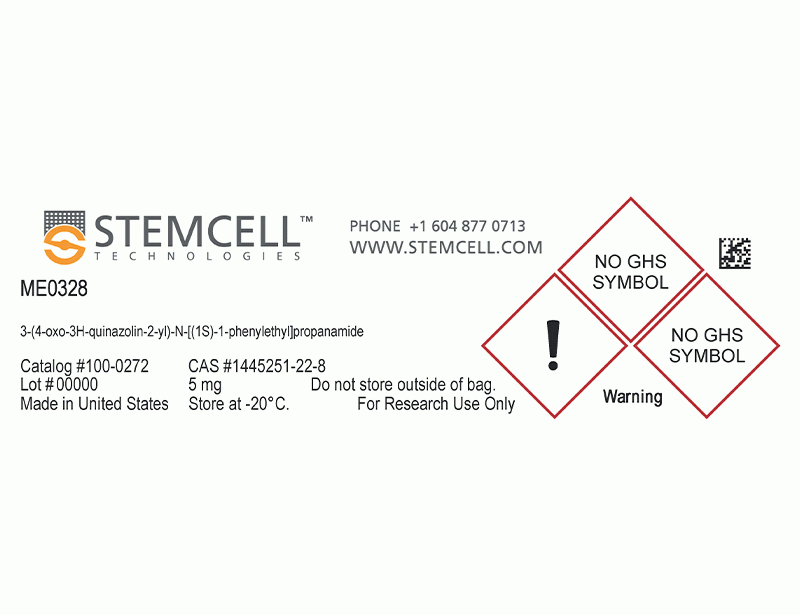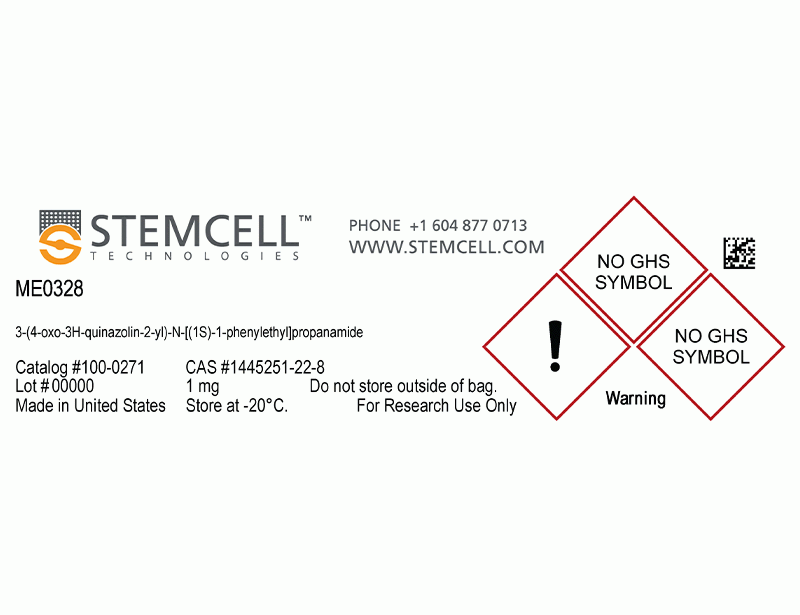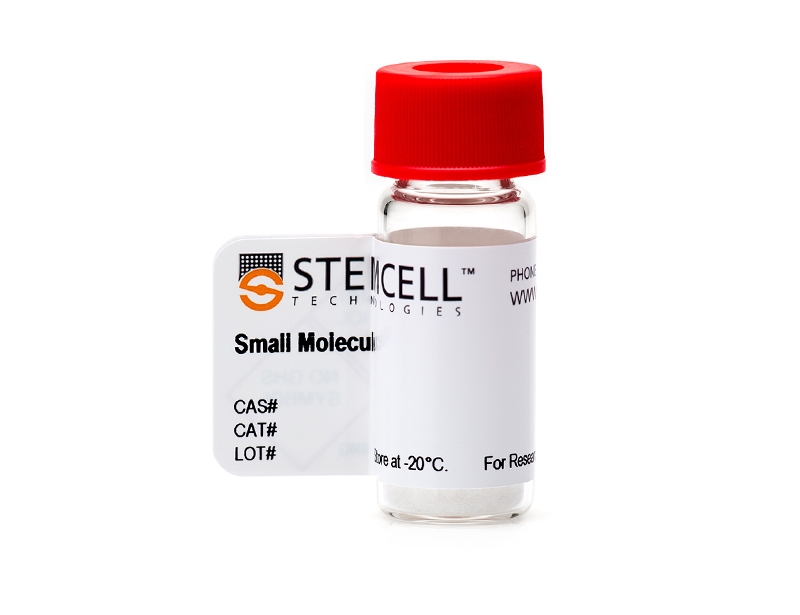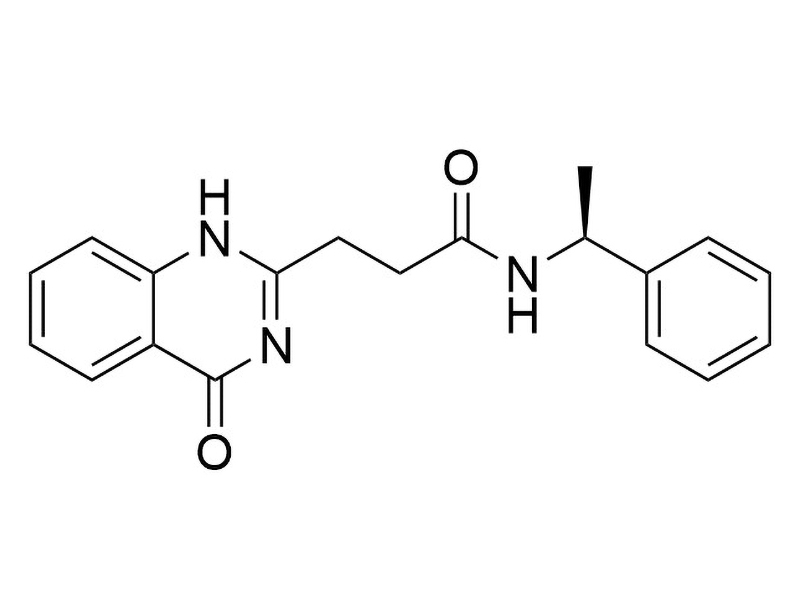ME0328
PARP-3 inhibitor
概要
ME0328 is a cell-permeable and selective inhibitor of poly(ADP-ribose) polymerase 3 (PARP-3; IC₅₀ = 0.89 µM; Lindgren et al.). PARP-3 is required for stabilization of the mitotic spindle and crucial for mitotic progression (Sharif-Askari et al.).
CANCER RESEARCH
· Enhances vinorelbine-induced microtubule destabilization, leading to cell cycle arrest and apoptosis in breast cancer cells (Sharif-Askari et al.).
CANCER RESEARCH
· Enhances vinorelbine-induced microtubule destabilization, leading to cell cycle arrest and apoptosis in breast cancer cells (Sharif-Askari et al.).
Area of Interest
Cancer Research, Mitosis
CAS Number
1445251-22-8
Chemical Formula
C₁₉H₁₉N₃O₂
Molecular Weight
321.4 g/mol
Purity
≥ 98%
Target
PARP3
技术资料
| Document Type | 产品名称 | Catalog # | Lot # | 语言 |
|---|---|---|---|---|
| Product Information Sheet | ME0328 | 100-0271, 100-0272 | All | English |
| Safety Data Sheet | ME0328 | 100-0271, 100-0272 | All | English |
数据及文献
Publications (2)
Breast cancer research and treatment 2018 nov
PARP3 inhibitors ME0328 and olaparib potentiate vinorelbine sensitization in breast cancer cell lines.
Abstract
Abstract
PURPOSE PARP-3 is member of the PARP family of poly (ADP-ribose) polymerases involved in ADPribosylation. PARPs are involved in the basic mechanisms of DNA repair. PARP3, a critical player for efficient mitotic progression, is required for the stabilization of the mitotic spindle by regulation of the mitotic components, NuMA and Tankyrase 1. METHODS The sensitization effect of vinorelbine on PARP3 inhibition-induced cytotoxicity was assessed by the SRB assay. The contribution of programed cell death and cell cycle arrest to the sensitization effect were determined by assessing changes in Annexin V, a marker of apoptosis. Alterations in cell cycle progression were assessed by cell cycle analysis. We used immunofluorescence to assess the effect of vinorelbine and/or PARP3 inhibitors on tubulin and microtubule depolarization. The PARP3 chemiluminescent assay kit was used for PARP3 activity. RESULTS PARP3 inhibitors sensitize breast cancer cells to vinorelbine, a vinca alkaloid used in the treatment of metastatic breast cancer. Olaparib which was originally described as a PARP1 and 2 inhibitor has recently been shown to be a potent PARP3 inhibitor while ME0328 is a more selective PARP3 inhibitor. The combination of vinorelbine with nontoxic concentrations of ME0328 or olaparib reduces vinorelbine resistance by 10 and 17 fold, respectively, potentiating vinorelbine-induced arrest at the G2/M boundary. In addition, PARP3 inhibition potentiates vinorelbine interaction with tubulin. Furthermore, olaparib or ME0328 potentiates vinorelbine-induced PARP3 inhibition, mitotic arrest, and apoptosis. CONCLUSION Our results indicated this approach with PARP3 inhibitors and vinorelbine is unique and promising for breast cancer patients with metastases. This combination could significantly increase the survival of breast cancer patients with metastases.
ACS chemical biology 2013 aug
PARP inhibitor with selectivity toward ADP-ribosyltransferase ARTD3/PARP3.
Abstract
Abstract
Inhibiting ADP-ribosyl transferases with PARP-inhibitors is considered a promising strategy for the treatment of many cancers and ischemia, but most of the cellular targets are poorly characterized. Here, we describe an inhibitor of ADP-ribosyltransferase-3/poly(ADP-ribose) polymerase-3 (ARTD3), a regulator of DNA repair and mitotic progression. In vitro profiling against 12 members of the enzyme family suggests selectivity for ARTD3, and crystal structures illustrate the molecular basis for inhibitor selectivity. The compound is active in cells, where it elicits ARTD3-specific effects at submicromolar concentration. Our results show that by targeting the nicotinamide binding site, selective inhibition can be achieved among the closest relatives of the validated clinical target, ADP-ribosyltransferase-1/poly(ADP-ribose) polymerase-1.




